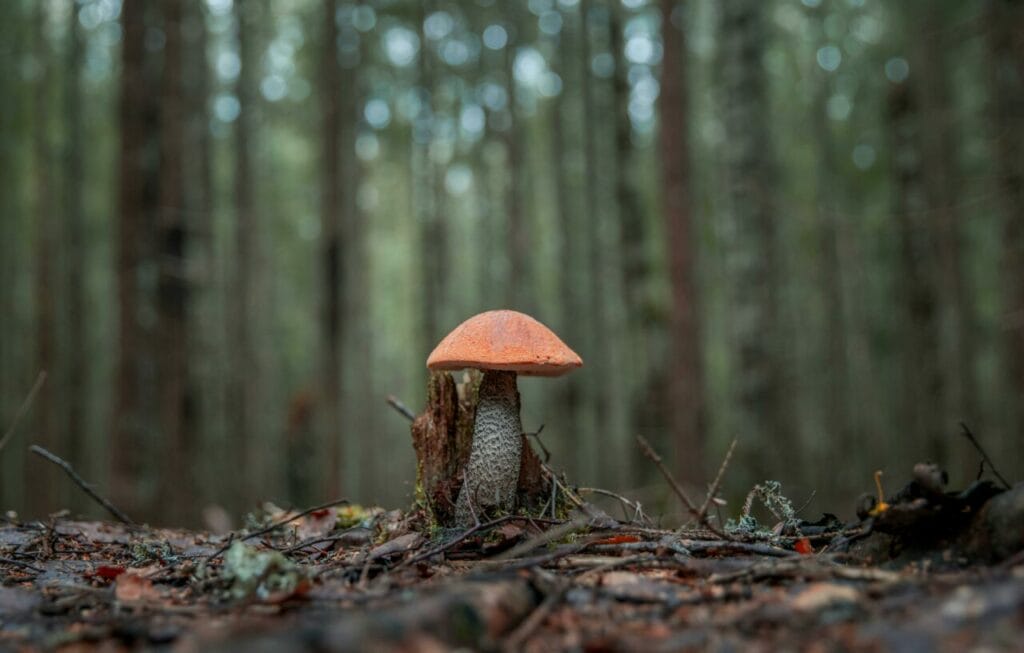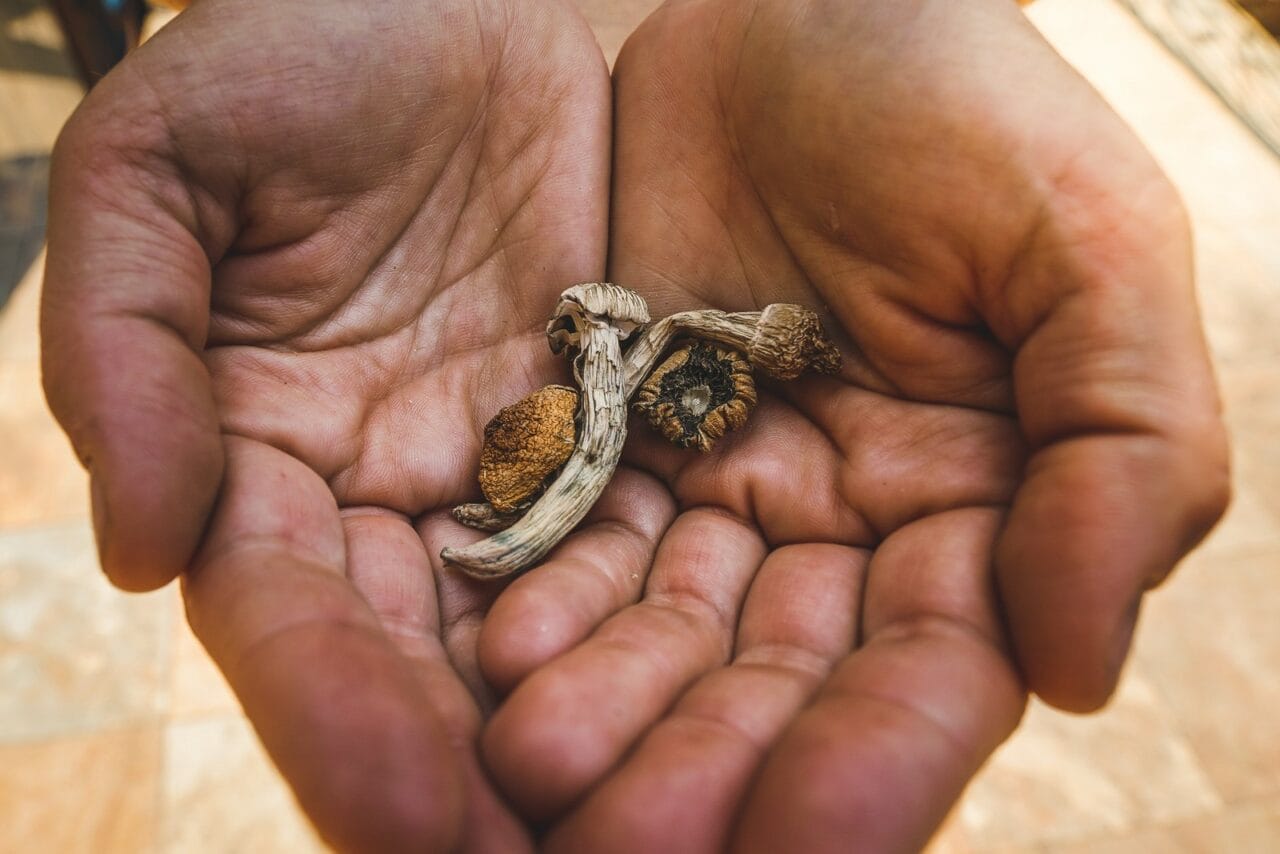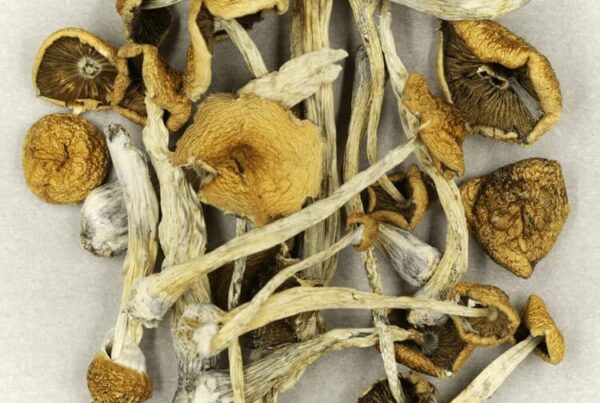Dried shrooms are among the most sought-after psychedelics currently available. Perhaps you’ve heard of them and considered trying them but are unsure if they are the right fit for you.
It’s not uncommon for novices to question which psychedelic to begin with. We’re here to elucidate the distinctions between dried mushrooms and other substances, and why they could be an excellent choice for your initial psychedelic experience.
[toc]Key Points to Remember:
- The active ingredient in Psilocybe is the most studied psychedelic for mental health due to its safety, minimal potential for misuse, and brief effect duration.
- Dehydrated Psilocybe is the most common form, as it retains potency and extends shelf life.
- Psilocybin stimulates the serotonin 5-HT2A receptor, leading to enhanced perception, vivid imagery, complex hallucinations, and time distortion.

Psilocybin Mushrooms: An Exploration of the Psychedelic Fungi Realm
A psilocybin mushroom contains the psychoactive substances psilocybin and psilocin, responsible for the hallucinogenic effects users experience. The most recognized species—Psilocybe cubensis—boasts a light brown cap, dark spots, and a distinctive shape. Several other species within the Psilocybe genus also generate these compounds.
Some toxic mushrooms, possessing harmful toxins, resemble the appearance of Psilocybe, which is why we strongly discourage picking shrooms.
Historically, many mushrooms played a significant role in Central American spiritual ceremonies. Presently, their potential for treating mental health disorders, including substance abuse disorders, is being researched.
Preparation and Preservation: The Dehydrated Form
The dried form of Psilocybe is the most accessible. Dehydration is essential to retain potency and extend shelf life. Fresh mushrooms are usually dried using a food dehydrator or placed on a wire rack in a cool, dry area.
This process is critical for removing excess
Magic mushrooms, once adequately dried, can be stored for future use. However, they must be kept free from moisture as it can lead to the growth of mould and cause degradation of the active compounds in the mushrooms.
Below is a comprehensive guide detailing the process of drying and storing magic mushrooms:
- Use a suitable food dehydrator or wire rack to thoroughly dry the mushrooms.
- Preserve the dried mushrooms in airtight containers to protect them from moisture and maintain their potency.
- Store them in a location that is cool and dry to preserve their psychoactive properties.
- Avoid exposing them to direct sunlight to prevent degradation.
- Regularly inspect them for mould or dark spots, which are indications of spoilage.
A Comparison of Psilocybe Cubensis with Other Psychedelics
There are various psychedelic products available online in addition to dried mushroom products. These products have different effects on the body and can be consumed in diverse ways. Some of these substances are termed classic hallucinogens, similar to psilocybin.
| Substance | Source | Physical Effects | Potential Research Applications | Duration |
| Psilocybin | Occurring naturally in over 200 species of mushrooms | Enhanced perception, hallucinations, altered sense of time | Depression, Anxiety, PTSD, OCD, Cluster headaches, Alzheimer’s disease | 4-6 hours |
| DMT | Naturally occurring in plants like Psychotria viridis | Profound spiritual experiences, visions, auditory hallucinations | Depression, Addiction | 15-30 minutes |
| LSD | Synthetic, first produced by Albert Hofmann in 1938 | Intensified emotions, altered perception, auditory and visual hallucinations | Depression, Anxiety, Addiction, Cluster headaches, Alzheimer’s disease, Tourette’s syndrome, ADHD | 8-12 hours |
| MDMA | Synthetic, initially synthesized by Anton Köllisch in 1912 | Increased release of serotonin, dopamine, norepinephrine, and potentially oxytocin | PTSD, Autism spectrum disorder, Obesity, Narcolepsy, ADHD | 3-6 hours |
| Ketamine | Synthetic, first synthesized by Calvin L. Stevens in 1962 | Anesthetic properties, produces psychedelic effects at high subanesthetic doses | Depression, Bipolar disorder, Anxiety, Suicidal ideation, Addiction, Autism spectrum disorder, Chronic pain, Arthritis, Fibromyalgia | 1-3 hours |
How Does Your Body Respond to These Substances?
The functional behaviors of each substance are theoretical and are based on observed outcomes. These theories offer some understanding of how these substances might manifest their effects, but they do not provide a complete explanation of the underlying mechanisms at work.
- Psilocybin: Easily stimulates the serotonin 5-HT2A receptor, causing enhanced perception, vivid imagery, complex hallucinations, and distortions in time. It also triggers alterations in thalamic gating and increased activity in the prefrontal cortex.
- DMT: Its effect on serotonin receptors is only a part of its overall impact, the full scope of which is still not fully understood. While the serotonin receptor plays a key role, it doesn’t fully account for all of DMT’s effects.
- LSD: It functions within the serotonergic system in the Dorsal Raphe, binding to the 5-HT2A receptor as a partial agonist, and the 5-HT1A receptor as a full agonist.
- MDMA: Produces an immediate feeling of pleasure by encouraging the release of dopamine and serotonin.
- Ketamine: The exact way it works is still unclear. Its antidepressant effect could be due to blocking NMDA receptors on neurons, though selective inhibition of NMDA receptors on GABAergic interneurons and suppression of AMPA receptors may also be involved.
What Are the Effects of Psychedelic Mushrooms?
The psychological and physical responses can vary significantly depending on the dosage, environment, and the user’s psychological state. Common experiences associated with the use of psychedelic mushrooms include:
- Visual and Auditory Hallucinations: Users may perceive patterns, colors, and shapes that don’t exist in real life.
- Distorted Sense of Time: Time may seem to slow down or speed up.
- Altered Perception: Sensory experiences may be intensified or distorted.
- Emotional Fluctuations: Users may experience a wide range of emotions, from happiness to anxiety.
- Spiritual Revelations: They may have experiences of a spiritual or mystical nature.
- Physical Effects: These include increased heart rate and blood pressure, and potential feelings of nausea.
Shrooms can be safely consumed when used responsibly. Lack of proper preparation, however, can result in unpleasant experiences, especially for less experienced users. While seasoned users may find higher doses effective, beginners attempting to consume large amounts may have a negative experience, often referred to as a “bad trip.”
Managing your experience with this substance is straightforward. Choose a calm, quiet environment and consider engaging a sober companion, often known as a “trip guide,” for support.
A Preferable Option Compared to Other Substances
Medical practitioners frequently prefer dried shrooms due to their longer shelf life and easy dosage. The shorter trip duration and more controlled intensity make it an appropriate choice for those new to psychedelic therapy. It also tends to be more natural than other synthetic hallucinogens, except for DMT.
Distinguishing the benefits of various compounds can be challenging as many clinical trials produce similar outcomes, particularly between LSD and psilocybin. The latter is the most extensively researched psychedelic for mental health issues, mainly due to its strong safety profile, low abuse potential, and shorter perceptual trips.
Health Benefits
- This natural substance may help decrease “cognitive rigidity,” reduce self-defeating thoughts, and promote self-compassion.
- A 2022 study demonstrated that a single 25 mg dose reduced depression scores in people with treatment-resistant depression. A 2023 study reported substantial and enduring reductions in depressive symptoms using a combination of regulated substances and psychotherapy.
- A 2022 clinical trial found that psilocybin-assisted psychotherapy significantly cut down the number of heavy drinking days over eight months compared to a placebo.
- A 2017 study published in the American Journal of Drug and Alcohol Abuse revealed that two to three doses, along with cognitive behavioural therapy (CBT), enabled 10 out of 15 participants to quit smoking for a year.
- In a 2022 pilot study published in Biological Psychiatry, four out of five patients with anorexia reported symptom improvement after a single dose of shroom combined with psychotherapy. Additionally, two of them reported a reduction in anxiety.
- Preparation Phase: This initial stage includes one or more sessions (lasting 1-6 hours each) with a facilitator. These sessions aim to address any concerns you might have, establish your goals, and set transparent expectations. They are designed to build trust and create a safe environment.
- Dosing Phase: This phase lasts between 5-8 hours. During this period, you will be reclining, wearing an eye mask, and listening to a pre-selected playlist. A therapist will accompany you throughout the entire experience.
- Integration Phase: This stage includes post-session meetings intended to help you understand and make sense of your experience. These sessions, spread across multiple meetings, each last several hours.
Is purchasing shroom products more cost-effective than other substances?
Compared to LSD products, dried mushrooms are considerably less expensive. For example, you can buy 3.5 grams for around $20. In contrast, the cost of LSD in gel tabs varies depending on the dosage. For instance, six tabs with a strength of 100 micrograms each might cost about $90.





